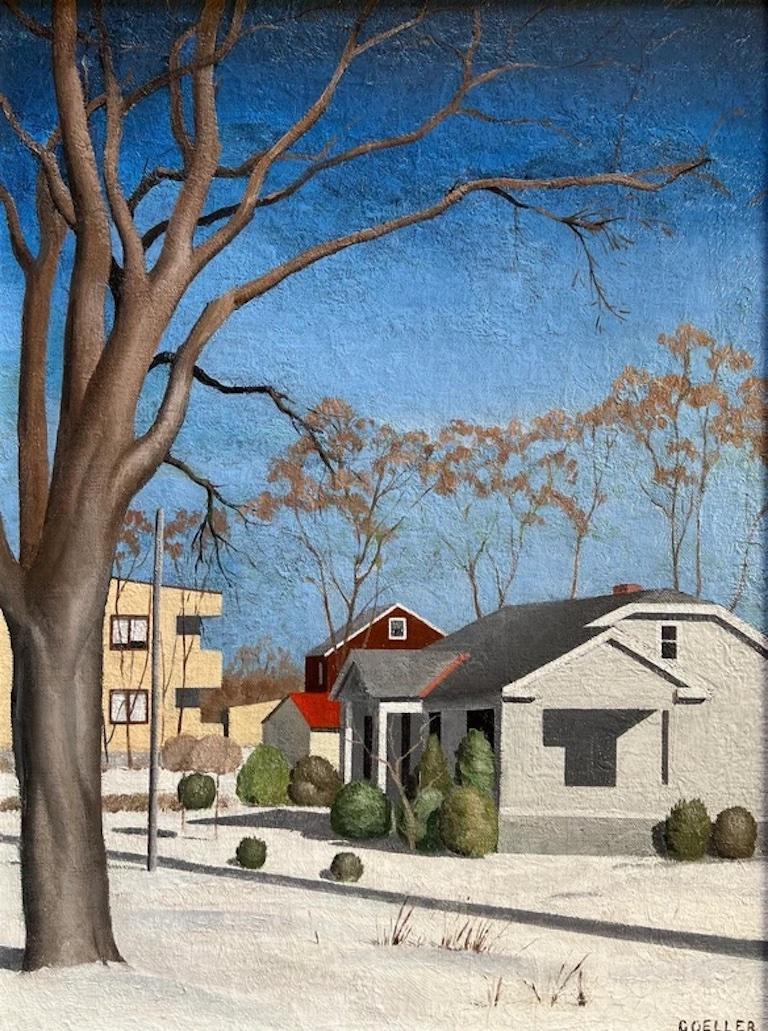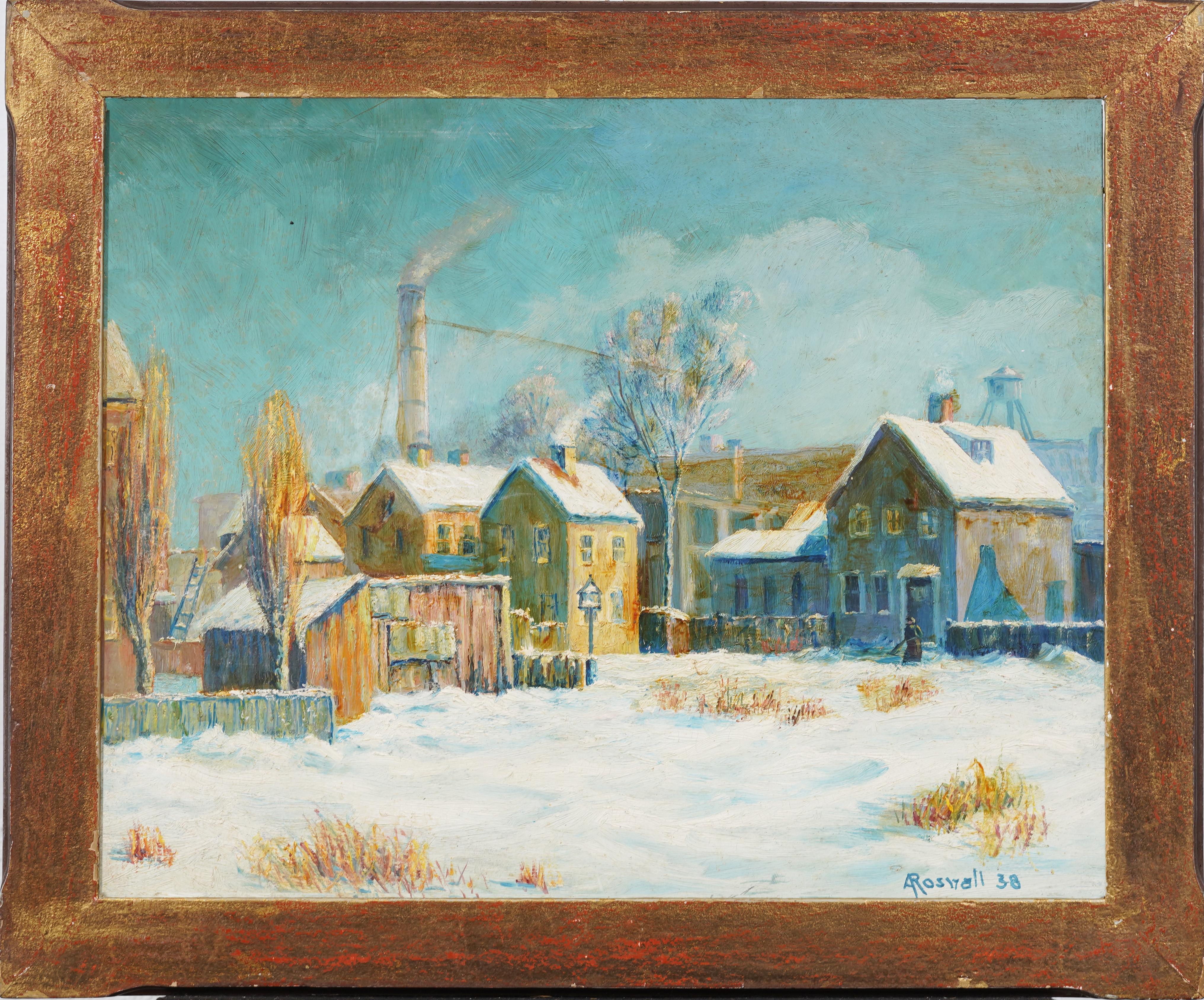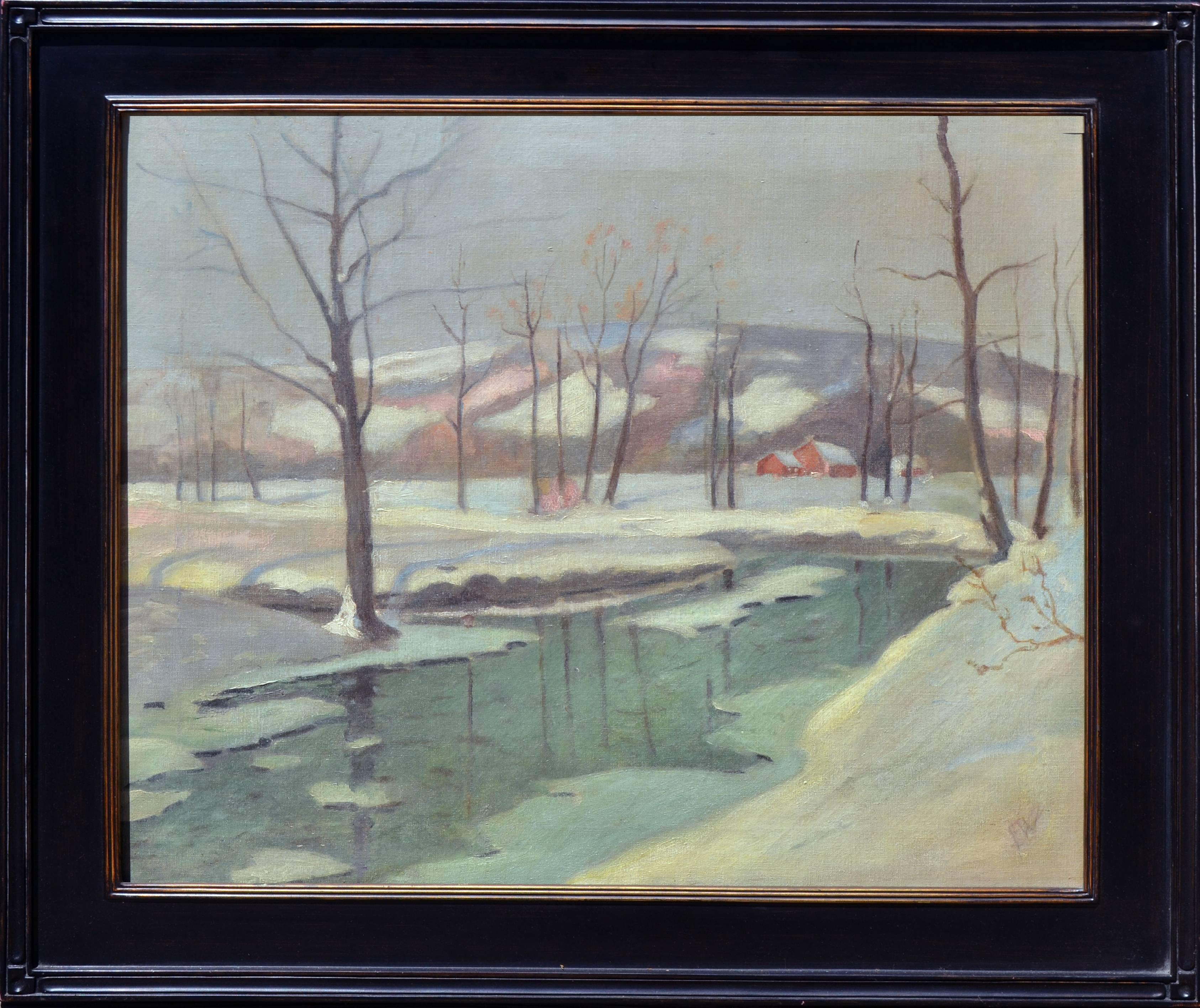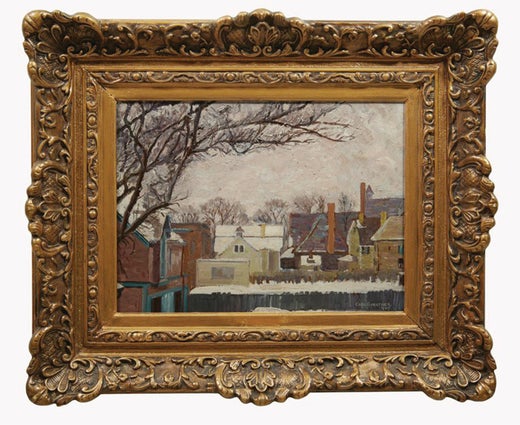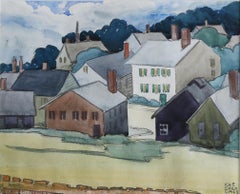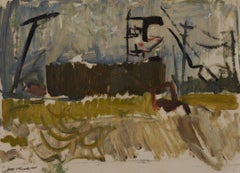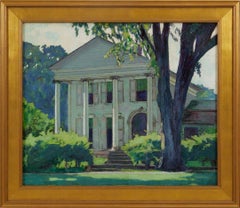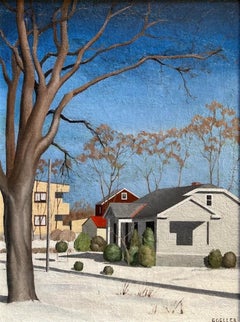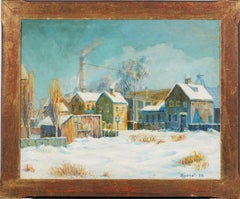Items Similar to Winter Rooftops, Backyard Landscape, American Scene Cleveland School Artist
Video Loading
Want more images or videos?
Request additional images or videos from the seller
1 of 17
Carl Frederick GaertnerWinter Rooftops, Backyard Landscape, American Scene Cleveland School Artist1945
1945
$4,000
£3,077.07
€3,571.60
CA$5,640.95
A$6,318.82
CHF 3,318.87
MX$76,834.80
NOK 42,027.75
SEK 39,895.64
DKK 26,656.23
About the Item
Carl Frederick Gaertner (American, 1898-1952)
Winter Rooftops, 1945
Oil on board
Signed and dated lower right
9.5 x 13 inches
17 x 20.5 inches, framed
Carl Gaertner was one of the greatest painters to emerge from the Cleveland School. Born in Cleveland on April 18, 1898, he graduated from East Technical high school in 1918 and attended Western Reserve College. From 1920 to 1923 he studied at the Cleveland School of Art (now the Cleveland Institute of Art) with Henry Keller. In 1922, he entered his first May Show at the Cleveland Museum of Art and was awarded a prize for an industrial oil painting. From 1925 until 1952, he was known as a pillar of the Cleveland School and one of their most prestigious painting instructors.
Gaertner’s subject matter was always drawn from the world around him. Early in his career, he focused on Cleveland and its environs. This interest never left him, but as he matured, his choice of subjects broadened. He painted watercolors and oils of Bermuda in the mid 1920s and began making frequent trips to Provincetown beginning in the 1920’s. Like other Cleveland artists, he culled inspiration from travels within the United States, notably trips through Pittsburgh’s dramatic industrial landscapes and Cambridge Springs in Pennsylvania, to the mountains of West Virginia, and to Cape Cod. From the mid 1940s until his death, he also produced paintings based on sketches made during train rides to visit galleries in New York City.
At the time of his premature death in 1952, Carl Gaertner enjoyed a considerable reputation as a master of American Scene painting. By the 1940s, Gaertner was represented by the venerable Macbeth Gallery in New York City and his paintings were exhibited in shows throughout the United States. In 1944 and 1952, Gaertner received the National Academy of Design’s highest award for individual work in a group exhibition, and his work was exhibited in the Cleveland Museum of Art’s May Show for 27 years. Gaertner’s works are in the collections of many prestigious institutions, including the Cleveland Museum of Art, the Metropolitan Museum of Art, the Chicago Institute and the Whitney Museum of American Art.
The reflective eye of Gaertner chronicled three decades of Cleveland and the landscapes of the Midwest and its people. It is all there: the growing might of industrial Cleveland; the mass-produced promise of the assembly line, giving way to a dawning awareness of lost freedom and the surrender of individuality; the love affair of Americans with nature and the ideals of Thoreau and Whitman and Frost; and the conflict between that love affair and industrial promise.
Gaertner was just achieving national acclaim at the time of his early death at the age of 54. A resurgence of enthusiasm for Gaertner and his works began in the 1970’s and has steadily increased and incrementally boosted the value of his work, with a fine rare example, “The Popcorn Man” reaching $250,000 at auction.
- Creator:Carl Frederick Gaertner (1898 - 1898, American)
- Creation Year:1945
- Dimensions:Height: 17 in (43.18 cm)Width: 20.5 in (52.07 cm)
- Medium:
- Period:
- Condition:
- Gallery Location:Beachwood, OH
- Reference Number:1stDibs: LU1768216323382
Carl Frederick Gaertner
Carl Gaertner was one of the greatest painters to emerge from the Cleveland School. Born in Cleveland on April 18, 1898, he graduated from East Technical high school in 1918 and attended Western Reserve College. From 1920 to 1923 he studied at the Cleveland School of Art (now the Cleveland Institute of Art) with Henry Keller. In 1922, he entered his first May Show at the Cleveland Museum of Art and was awarded a prize for an industrial oil painting. From 1925 until 1952, he was known as a pillar of the Cleveland School and one of their most prestigious painting instructors. Gaertner’s subject matter was always drawn from the world around him. Early in his career, he focused on Cleveland and its environs. This interest never left him, but as he matured, his choice of subjects broadened. He painted watercolors and oils of Bermuda in the mid 1920s and began making frequent trips to Provincetown beginning in the 1920’s. Like other Cleveland artists, he culled inspiration from travels within the United States, notably trips through Pittsburgh’s dramatic industrial landscapes and Cambridge Springs in Pennsylvania, to the mountains of West Virginia, and to Cape Cod. From the mid 1940s until his death, he also produced paintings based on sketches made during train rides to visit galleries in New York City. At the time of his premature death in 1952, Carl Gaertner enjoyed a considerable reputation as a master of American Scene painting. By the 1940s, Gaertner was represented by the venerable Macbeth Gallery in New York City and his paintings were exhibited in shows throughout the United States. In 1944 and 1952, Gaertner received the National Academy of Design’s highest award for individual work in a group exhibition, and his work was exhibited in the Cleveland Museum of Art’s May Show for 27 years. Gaertner’s works are in the collections of many prestigious institutions, including the Cleveland Museum of Art, the Metropolitan Museum of Art, the Chicago Institute and the Whitney Museum of American Art. The reflective eye of Gaertner chronicled three decades of Cleveland and the landscapes of the Midwest and its people. It is all there: the growing might of industrial Cleveland; the mass-produced promise of the assembly line, giving way to a dawning awareness of lost freedom and the surrender of individuality; the love affair of Americans with nature and the ideals of Thoreau and Whitman and Frost; and the conflict between that love affair and industrial promise. Gaertner was just achieving national acclaim at the time of his early death at the age of 54. A resurgence of enthusiasm for Gaertner and his works began in the 1970’s and has steadily increased and incrementally boosted the value of his work, with a fine rare example, “The Popcorn Man” reaching $250,000 at auction.
About the Seller
5.0
Vetted Professional Seller
Every seller passes strict standards for authenticity and reliability
Established in 1975
1stDibs seller since 2022
34 sales on 1stDibs
Typical response time: 1 hour
- ShippingRetrieving quote...Shipping from: Beachwood, OH
- Return Policy
Authenticity Guarantee
In the unlikely event there’s an issue with an item’s authenticity, contact us within 1 year for a full refund. DetailsMoney-Back Guarantee
If your item is not as described, is damaged in transit, or does not arrive, contact us within 7 days for a full refund. Details24-Hour Cancellation
You have a 24-hour grace period in which to reconsider your purchase, with no questions asked.Vetted Professional Sellers
Our world-class sellers must adhere to strict standards for service and quality, maintaining the integrity of our listings.Price-Match Guarantee
If you find that a seller listed the same item for a lower price elsewhere, we’ll match it.Trusted Global Delivery
Our best-in-class carrier network provides specialized shipping options worldwide, including custom delivery.More From This Seller
View AllNew England Coastal Town Landscape w/ Houses, Cleveland School Woman Artist
Located in Beachwood, OH
Kae Dorn Cass (American, 1901-1971)
New England Coastal Town
Watercolor on paper
Signed lower right
9 in. h. x 11.5 in. w.
17 in. h. x 19 in. w., as framed
Kae Dorn Cass was born...
Category
Mid-20th Century Figurative Drawings and Watercolors
Materials
Watercolor
20th Century Industrial Cityscape Oil painting, Cleveland School Artist
By Joseph O'Sickey
Located in Beachwood, OH
Work sold to benefit the CLEVELAND INSTITUTE OF ART
Joseph B. O’Sickey (American, 1918–2013)
Industrial Cityscape
Oil on paper
Signed lower left
13.75 x 16.5 inches
Joseph O'Sicke...
Category
Late 20th Century Post-Impressionist Landscape Paintings
Materials
Oil
Early 20th Century Landscape with Covered Bridge, Female Cleveland School Artist
By May Ames
Located in Beachwood, OH
May Lydia Ames (American, 1863-1943)
Landscape with Covered Bridge
Oil on canvas
Signed lower left
9.75 x 8 inches
14.5 x 13 inches, framed
May Ames was born in Cleveland in 1863 an...
Category
Early 20th Century American Impressionist Figurative Paintings
Materials
Oil
House in Hudson, Ohio, Late 19th Century Painting by Cleveland School Artist
Located in Beachwood, OH
Ora Coltman (American, 1858-1940)
House in Hudson, OH
Oil on canvas
Signed lower left
22 x 26 inches
27.5 x 31.5 inches, framed
21 Aurora Street is locally known as the Isham-Beebe ...
Category
Late 19th Century American Modern Figurative Paintings
Materials
Oil
Flower Garden, Cape Cod, Mid-Century Cleveland School Painting
By Carl Frederick Gaertner
Located in Beachwood, OH
Carl Frederick Gaertner (American, 1898-1952)
Flower Garden, Cape Cod, c. 1940s
Gouache on illustration board
17.5 x 29 inches
27 x 39 inches, as framed
Carl Gaertner was one of the greatest painters to emerge from the Cleveland School...
Category
1940s American Realist Figurative Paintings
Materials
Gouache
Early 20th Century Impressionist Seascape, Harbor and Town Scene
By Charles Salis Kaelin
Located in Beachwood, OH
Charles Salis Kaelin (American, 1858–1929)
Harbor and Town
Oil on canvas
25.75 in. h. x 27.75 in. w., as framed
18 in. h. x 20 in. w., canvas
Described as an artist whose "love of nature amounted to a passion," Charles Salis Kaelin was one of the earliest American exponents of Divisionism. A respected member of the art colony at Rockport, Massachusetts, Kaelin's colorful renderings of Cape Ann...
Category
20th Century Post-Impressionist Landscape Paintings
Materials
Oil
You May Also Like
Antique American Modernist Signed Oil Painting Houses in Winter 1920 Framed
Located in Buffalo, NY
Antique American modernist view of homes in winter signed Timmens.
Oil on board, circa 1935. Signed.
Displayed in a period modernist frame. Image, 24"L x 20"H, overall 30"L x 25"H.
Category
1920s Modern Landscape Paintings
Materials
Canvas, Oil
$1,516 Sale Price
20% Off
Suburb (in Winter)
Located in Los Angeles, CA
This painting is part of our exhibition Charles Goeller: A Wistful Loneliness.
Oil on canvas, 20 x 15 inches, Signed lower right
Exhibited:
1) Portrai...
Category
1940s American Modern Landscape Paintings
Materials
Oil
Antique American Signed Winter Impressionist Roxbury Boston Town Oil Painting
Located in Buffalo, NY
Antique American impressionist winter cityscape oil painting. Oil on board. Signed. Framed. Measuring 20 by 24 inches overall and 16 by 20 painting alone. In excellent original cond...
Category
1930s Impressionist Landscape Paintings
Materials
Canvas, Oil
$1,020 Sale Price
20% Off
Antique American Winter Landscape Oil Painting of an Old New England Village
Located in Douglas Manor, NY
5160 Antique winter landscape oil painting
Framed .
Image size 15.5x19.5"
Signed H.Katz 1945
Category
1940s Landscape Paintings
Materials
Oil
Landscape with Farm House in Winter
By Charles Frederick Surendorf
Located in San Francisco, CA
This artwork "Landscape with Farm House in Winter" c.1950, is a oil painting on hardboard by noted California artist Charles Frederick Surendorf, 1906-1979. It is signed at the lower...
Category
Mid-20th Century American Impressionist Landscape Paintings
Materials
Oil
A Winter Scene - Snowy 1930's Landscape
By Frederick R. Wagner
Located in Soquel, CA
Serene winter landscape of a snow covered hills with a frozen creek and far off house in the distance by Frederick Wagner (American, 1864-1940), c.1930's. Signed "F. W." lower right....
Category
1930s American Impressionist Landscape Paintings
Materials
Canvas, Oil
More Ways To Browse
Codor Design
Bermuda Painting
Cambridge 1920s
19th Century Western Oil Paintings
California Wildflowers
Italian Oil Painting Wine
Paintings By Cortes
Watch 1942
Brave Fine Art
Dutch Painting Oil Seascape
Jean Renoir
John Stanford
Lavender In Provence
Newlyn School
Scottish Sheep
Wheat Field Painting
16th Century Still Life
Alfred Martin
